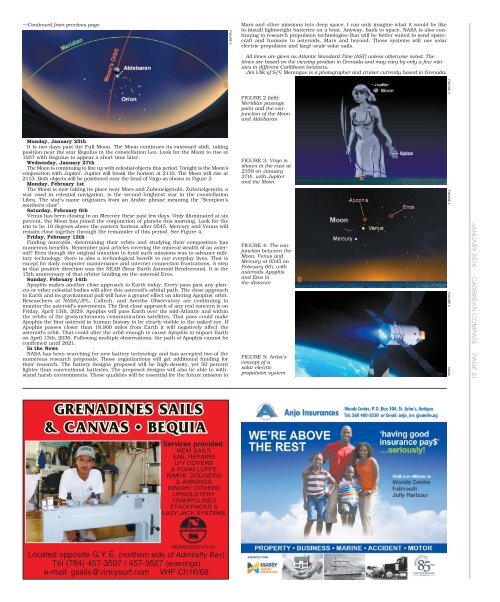Caribbean Compass Yachting Magazine January 2016
Welcome to Caribbean Compass, the most widely-read boating publication in the Caribbean! THE MOST NEWS YOU CAN USE - feature articles on cruising destinations, regattas, environment, events...
Welcome to Caribbean Compass, the most widely-read boating publication in the Caribbean! THE MOST NEWS YOU CAN USE - feature articles on cruising destinations, regattas, environment, events...
You also want an ePaper? Increase the reach of your titles
YUMPU automatically turns print PDFs into web optimized ePapers that Google loves.
— Continued from previous page<br />
FIGURE 2<br />
Mars and other missions into deep space. I can only imagine what it would be like<br />
to install lightweight batteries on a boat. Anyway, back to space. NASA is also continuing<br />
to research propulsion technologies that will be better suited to send spacecraft<br />
and humans to asteroids, Mars and beyond. Those systems will use solar<br />
electric propulsion and large-scale solar sails.<br />
All times are given as Atlantic Standard Time (AST) unless otherwise noted. The<br />
times are based on the viewing position in Grenada and may vary by only a few minutes<br />
in different <strong>Caribbean</strong> locations.<br />
Jim Ulik of S/V Merengue is a photographer and cruiser currently based in Grenada.<br />
FIGURE 2 (left):<br />
Meridian passage<br />
point and the conjunction<br />
of the Moon<br />
and Aldebaran<br />
FIGURE 3<br />
Monday, <strong>January</strong> 25th<br />
It is two days past the Full Moon. The Moon continues its eastward shift, taking<br />
position near the star Regulus in the constellation Leo. Look for the Moon to rise at<br />
1937 with Regulus to appear a short time later.<br />
Wednesday, <strong>January</strong> 27th<br />
The Moon is continuing to line up with celestial objects this period. Tonight is the Moon’s<br />
conjunction with Jupiter. Jupiter will break the horizon at 2110. The Moon will rise at<br />
2113. Both objects will be positioned near the head of Virgo as shown in Figure 3.<br />
Monday, February 1st<br />
The Moon is now taking its place near Mars and Zubenelgenubi. Zubenelgenubi, a<br />
star used in celestial navigation, is the second brightest star in the constellation<br />
Libra. The star’s name originates from an Arabic phrase meaning the “Scorpion’s<br />
southern claw”.<br />
Saturday, February 6th<br />
Venus has been closing in on Mercury these past few days. Only illuminated at six<br />
percent, the Moon has joined the conjunction of planets this morning. Look for the<br />
trio to be 10 degrees above the eastern horizon after 0545. Mercury and Venus will<br />
remain close together through the remainder of this period. See Figure 4.<br />
Friday, February 12th<br />
Finding asteroids, determining their orbits and studying their composition has<br />
numerous benefits. Remember past articles covering the mineral wealth of an asteroid?<br />
Even though the original intention to fund such missions was to advance military<br />
technology, there is also a technological benefit to our everyday lives. That is<br />
except for daily computer maintenance and internet connection frustrations. A step<br />
in that positive direction was the NEAR (Near Earth Asteroid Rendezvous). It is the<br />
15th anniversary of that orbiter landing on the asteroid Eros.<br />
Sunday, February 14th<br />
Apophis makes another close approach to Earth today. Every pass past any planets<br />
or other celestial bodies will alter this asteroid’s orbital path. The close approach<br />
to Earth and its gravitational pull will have a greater effect on altering Apophis’ orbit.<br />
Researchers at NASA/JPL, Caltech, and Arecibo Observatory are continuing to<br />
monitor the asteroid’s movements. The first close approach of any real concern is on<br />
Friday, April 13th, 2029. Apophis will pass Earth over the mid-Atlantic and within<br />
the orbits of the geosynchronous communication satellites. That pass could make<br />
Apophis the first asteroid in human history to be clearly visible to the naked eye. If<br />
Apophis passes closer than 18,900 miles from Earth it will negatively affect the<br />
asteroid’s orbit. That could alter the orbit enough to cause Apophis to impact Earth<br />
on April 13th, 2036. Following multiple observations, the path of Apophis cannot be<br />
confirmed until 2021.<br />
In the News<br />
NASA has been searching for new battery technology and has accepted two of the<br />
numerous research proposals. Those organizations will get additional funding for<br />
their research. The battery designs proposed will be high-density, yet 50 percent<br />
lighter than conventional batteries. The proposed designs will also be able to withstand<br />
harsh environments. Those qualities will be essential for the future mission to<br />
FIGURE 3: Virgo is<br />
shown in the east at<br />
2358 on <strong>January</strong><br />
27th, with Jupiter<br />
and the Moon<br />
FIGURE 4: The conjunction<br />
between the<br />
Moon, Venus and<br />
Mercury at 0545 on<br />
February 6th, with<br />
asteroids Apophis<br />
and Eros in<br />
the distance<br />
FIGURE 5: Artist’s<br />
concept of a<br />
solar electric<br />
propulsion system<br />
FIGURE 4 FIGURE 5 NASA<br />
JANUARY <strong>2016</strong> CARIBBEAN COMPASS PAGE 41<br />
GRENADINES<br />
SAILS<br />
& CANVAS • BEQUIA<br />
Services provided:<br />
NEW SAILS<br />
SAIL REPAIRS<br />
U/V COVERS<br />
& FOAM LUFFS<br />
BIMINI, DODGERS<br />
& AWNINGS<br />
DINGHY COVERS<br />
UPHOLSTERY<br />
TRAMPOLINES<br />
STACKPACKS &<br />
LAZY JACK SYSTEMS<br />
REPRESENTATIVE<br />
Located opposite G.Y.E. (northern side of Admiralty Bay)<br />
Tel (784) 457-3507 / 457-3527 (evenings)<br />
e-mail: gsails@vincysurf.com VHF Ch16/68


















